Community Health Assessment of Aboriginal Older Adults in WA
VerifiedAdded on 2022/09/22
|12
|3030
|22
Report
AI Summary
This report provides a comprehensive community health assessment of Aboriginal older adults living in Western Australia. It begins with an introduction highlighting the importance of assessing the health of the Aboriginal population and the existing health inequalities compared to the non-Aboriginal population. The demographics section reveals that Aboriginals represent a small percentage of the total population in Western Australia, with a significantly lower life expectancy and a smaller proportion of older adults (65+ years) compared to the non-Aboriginal population. The report then addresses key health issues, including chronic diseases like diabetes, cardiovascular diseases, and kidney-related complications, which are more prevalent and lead to higher mortality rates among the Aboriginal population. Social determinants of health such as poverty, low education levels, inadequate housing, and cultural factors are identified as significant contributors to these health disparities. The report concludes by suggesting health promotion strategies, specifically focusing on health literacy related to kidney disease, to empower the Aboriginal population and improve their health outcomes. The report emphasizes the need for culturally sensitive healthcare services and interventions to address the unique challenges faced by Aboriginal older adults in Western Australia.

Running head: COMMUNITY HEALTH ASSESSMENT 1
Community Health Assessment of the Aboriginal Older Adults living in Western Australia
Name of Author
Institution
Date of Submission
Community Health Assessment of the Aboriginal Older Adults living in Western Australia
Name of Author
Institution
Date of Submission
Paraphrase This Document
Need a fresh take? Get an instant paraphrase of this document with our AI Paraphraser

COMMUNITY HEALTH ASSESSMENT 2
Community Health Assessment of the Aboriginal Older Adults living in Western Australia
Introduction
Community health assessment is critical towards assessing the health of a society.
Western Australia is inhabited people of varied backgrounds and affiliations. The Aboriginals
living in Western Australia will be of particular interest to this paper. For a long time, the
inequality and gaps in healthcare was witnessed among the Aboriginals relative to the Non-
Aboriginal population (Sabbioni et al., 2018). The assessment would provide a framework that
would enable policymakers and healthcare professionals to improve the quality of health of older
adults among the Aboriginal population in Western Australia (Tsou et al., 2018). This paper will
be based on literature review of both journals and government publications about the Aboriginals
in Western Australia. This paper targets peers, scholars and educators as audience. This paper
will determine the demographics related to older adults among the Aboriginals living in Western
Australia. Further, it will assess the health status of the Aboriginals as well as their social health
determinants. Lastly, the report would indicate a possible health care issue that would require a
health promotion later.
Demographics
The population of Aboriginals in Western Australia is about 3.9% of the total population.
The Aboriginal community is associated with lower life expectancy relative to other populations
in Western Australia. Typically, older adults aged 65 years and above among the Aboriginal
people represent only 3.7% of the total Aboriginal population. Comparatively, older adults aged
Community Health Assessment of the Aboriginal Older Adults living in Western Australia
Introduction
Community health assessment is critical towards assessing the health of a society.
Western Australia is inhabited people of varied backgrounds and affiliations. The Aboriginals
living in Western Australia will be of particular interest to this paper. For a long time, the
inequality and gaps in healthcare was witnessed among the Aboriginals relative to the Non-
Aboriginal population (Sabbioni et al., 2018). The assessment would provide a framework that
would enable policymakers and healthcare professionals to improve the quality of health of older
adults among the Aboriginal population in Western Australia (Tsou et al., 2018). This paper will
be based on literature review of both journals and government publications about the Aboriginals
in Western Australia. This paper targets peers, scholars and educators as audience. This paper
will determine the demographics related to older adults among the Aboriginals living in Western
Australia. Further, it will assess the health status of the Aboriginals as well as their social health
determinants. Lastly, the report would indicate a possible health care issue that would require a
health promotion later.
Demographics
The population of Aboriginals in Western Australia is about 3.9% of the total population.
The Aboriginal community is associated with lower life expectancy relative to other populations
in Western Australia. Typically, older adults aged 65 years and above among the Aboriginal
people represent only 3.7% of the total Aboriginal population. Comparatively, older adults aged

COMMUNITY HEALTH ASSESSMENT 3
65 years and above represent 14 % among the non-Aboriginal population. These statistics
indicate a huge disparity in health care experiences and services. The disparity also indicates the
early onset as well as poor management of long-term chronic diseases (AMHMAC, 2017).
Statistics also indicate that the incidences of chronic health conditions are higher among
the Aboriginal populations in Western Australia than other non-Aboriginal populations (Calma
et al., 2017). The hospitalization rates for chronic disease relates to health complications in
Western Australia is 4.3 times higher than that for Non-Aboriginal people within the same
region. In effect, the highest death rate from chronic diseases in Western Australia is from the
Aboriginal population. Chronic diseases include diabetes, cardiovascular diseases, and kidney-
related complications. The life span of Aboriginals is approximately 14 years lower than that of
other populations in Western Australia. Females among the aboriginals have a lifespan of about
67 years, while men have an average lifespan of 61 years (AMHMAC, 2017).
Health Issues
The health issues affecting the Aboriginal population in Western Australia have led to
low life expectancy, and high mortality rates as well as increased incidences of self-harm. The
experiences of the Aboriginal people are different from those of the Non-Aboriginal populations
in Western Australia. The Aboriginals are associated with poor health experiences from an early
age (Calma et al., 2017). This leads to aging problems early in life relative to other non-
Aboriginals in Western Australia, explaining the low life expectancy among them. The
premature aging and high prevalence of chronic diseases place the Aboriginal community a
priority for targeted health policies that can improve their health and wellbeing like other Non-
Aboriginal populations in Western Australia (Loh et al., 2016). There is a need by the State
65 years and above represent 14 % among the non-Aboriginal population. These statistics
indicate a huge disparity in health care experiences and services. The disparity also indicates the
early onset as well as poor management of long-term chronic diseases (AMHMAC, 2017).
Statistics also indicate that the incidences of chronic health conditions are higher among
the Aboriginal populations in Western Australia than other non-Aboriginal populations (Calma
et al., 2017). The hospitalization rates for chronic disease relates to health complications in
Western Australia is 4.3 times higher than that for Non-Aboriginal people within the same
region. In effect, the highest death rate from chronic diseases in Western Australia is from the
Aboriginal population. Chronic diseases include diabetes, cardiovascular diseases, and kidney-
related complications. The life span of Aboriginals is approximately 14 years lower than that of
other populations in Western Australia. Females among the aboriginals have a lifespan of about
67 years, while men have an average lifespan of 61 years (AMHMAC, 2017).
Health Issues
The health issues affecting the Aboriginal population in Western Australia have led to
low life expectancy, and high mortality rates as well as increased incidences of self-harm. The
experiences of the Aboriginal people are different from those of the Non-Aboriginal populations
in Western Australia. The Aboriginals are associated with poor health experiences from an early
age (Calma et al., 2017). This leads to aging problems early in life relative to other non-
Aboriginals in Western Australia, explaining the low life expectancy among them. The
premature aging and high prevalence of chronic diseases place the Aboriginal community a
priority for targeted health policies that can improve their health and wellbeing like other Non-
Aboriginal populations in Western Australia (Loh et al., 2016). There is a need by the State
⊘ This is a preview!⊘
Do you want full access?
Subscribe today to unlock all pages.

Trusted by 1+ million students worldwide

COMMUNITY HEALTH ASSESSMENT 4
department of health to review the delivery and planning of health services to take into account
the social and cultural needs of this vulnerable population.
Chronic diseases hold the dominant percentage of disease burden in Western Australia.
The chronic diseases affecting the Aboriginals largely are often avoidable and can be controlled
to reduce the high hospitalization rates (Lindeman et al., 2017). Some of the major ailments
affecting the Aboriginals in Western Australia include high blood pressure, diabetes,
cardiovascular diseases, cancer, and kidney diseases. It is worth highlighting that most of the
chronic diseases begin at a relatively younger age among the Aboriginals compared to Non-
aboriginals. Consequently, the incidence of death caused by the chronic diseases is higher among
Aboriginals than non-Aboriginals ("Chronic diseases - Western Australia - Australian
Indigenous HealthInfoNet", 2020).
For a long time, the Aboriginal population has always complained about the lack of
effective and high quality of culturally sensitive health services (Sabbioni et al., 2018). Most of
the statistics for poor health outcomes in Western Australia among the Aboriginals can be
attributed to lack of culturally-competent health services. Further, there is relatively low literacy
among the Aboriginals relative to other non-Aboriginal communities; the disparity has ensured
that there are less healthcare workers from the Aboriginal community. Also, illiteracy affects the
implementation of health policies effectively, especially for the aboriginals living in remote
places (Durey et al., 2016). The distribution of Aboriginals in Western Australia is not uniform.
They live in towns, remote, rural, and isolated areas across the region. There is a close cultural
affiliation in relation to the older adults among the Aboriginals. As such, they tend to be
department of health to review the delivery and planning of health services to take into account
the social and cultural needs of this vulnerable population.
Chronic diseases hold the dominant percentage of disease burden in Western Australia.
The chronic diseases affecting the Aboriginals largely are often avoidable and can be controlled
to reduce the high hospitalization rates (Lindeman et al., 2017). Some of the major ailments
affecting the Aboriginals in Western Australia include high blood pressure, diabetes,
cardiovascular diseases, cancer, and kidney diseases. It is worth highlighting that most of the
chronic diseases begin at a relatively younger age among the Aboriginals compared to Non-
aboriginals. Consequently, the incidence of death caused by the chronic diseases is higher among
Aboriginals than non-Aboriginals ("Chronic diseases - Western Australia - Australian
Indigenous HealthInfoNet", 2020).
For a long time, the Aboriginal population has always complained about the lack of
effective and high quality of culturally sensitive health services (Sabbioni et al., 2018). Most of
the statistics for poor health outcomes in Western Australia among the Aboriginals can be
attributed to lack of culturally-competent health services. Further, there is relatively low literacy
among the Aboriginals relative to other non-Aboriginal communities; the disparity has ensured
that there are less healthcare workers from the Aboriginal community. Also, illiteracy affects the
implementation of health policies effectively, especially for the aboriginals living in remote
places (Durey et al., 2016). The distribution of Aboriginals in Western Australia is not uniform.
They live in towns, remote, rural, and isolated areas across the region. There is a close cultural
affiliation in relation to the older adults among the Aboriginals. As such, they tend to be
Paraphrase This Document
Need a fresh take? Get an instant paraphrase of this document with our AI Paraphraser
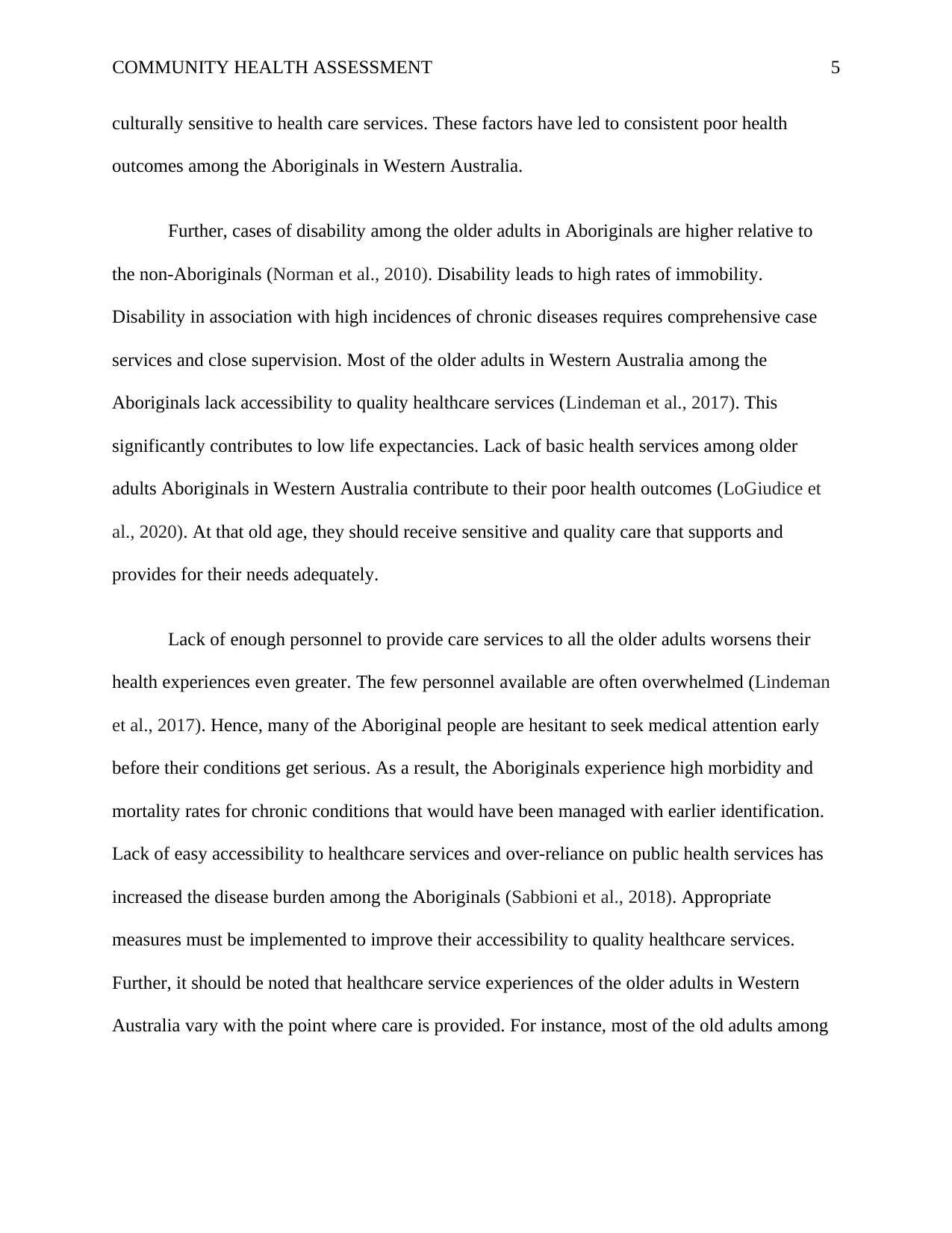
COMMUNITY HEALTH ASSESSMENT 5
culturally sensitive to health care services. These factors have led to consistent poor health
outcomes among the Aboriginals in Western Australia.
Further, cases of disability among the older adults in Aboriginals are higher relative to
the non-Aboriginals (Norman et al., 2010). Disability leads to high rates of immobility.
Disability in association with high incidences of chronic diseases requires comprehensive case
services and close supervision. Most of the older adults in Western Australia among the
Aboriginals lack accessibility to quality healthcare services (Lindeman et al., 2017). This
significantly contributes to low life expectancies. Lack of basic health services among older
adults Aboriginals in Western Australia contribute to their poor health outcomes (LoGiudice et
al., 2020). At that old age, they should receive sensitive and quality care that supports and
provides for their needs adequately.
Lack of enough personnel to provide care services to all the older adults worsens their
health experiences even greater. The few personnel available are often overwhelmed (Lindeman
et al., 2017). Hence, many of the Aboriginal people are hesitant to seek medical attention early
before their conditions get serious. As a result, the Aboriginals experience high morbidity and
mortality rates for chronic conditions that would have been managed with earlier identification.
Lack of easy accessibility to healthcare services and over-reliance on public health services has
increased the disease burden among the Aboriginals (Sabbioni et al., 2018). Appropriate
measures must be implemented to improve their accessibility to quality healthcare services.
Further, it should be noted that healthcare service experiences of the older adults in Western
Australia vary with the point where care is provided. For instance, most of the old adults among
culturally sensitive to health care services. These factors have led to consistent poor health
outcomes among the Aboriginals in Western Australia.
Further, cases of disability among the older adults in Aboriginals are higher relative to
the non-Aboriginals (Norman et al., 2010). Disability leads to high rates of immobility.
Disability in association with high incidences of chronic diseases requires comprehensive case
services and close supervision. Most of the older adults in Western Australia among the
Aboriginals lack accessibility to quality healthcare services (Lindeman et al., 2017). This
significantly contributes to low life expectancies. Lack of basic health services among older
adults Aboriginals in Western Australia contribute to their poor health outcomes (LoGiudice et
al., 2020). At that old age, they should receive sensitive and quality care that supports and
provides for their needs adequately.
Lack of enough personnel to provide care services to all the older adults worsens their
health experiences even greater. The few personnel available are often overwhelmed (Lindeman
et al., 2017). Hence, many of the Aboriginal people are hesitant to seek medical attention early
before their conditions get serious. As a result, the Aboriginals experience high morbidity and
mortality rates for chronic conditions that would have been managed with earlier identification.
Lack of easy accessibility to healthcare services and over-reliance on public health services has
increased the disease burden among the Aboriginals (Sabbioni et al., 2018). Appropriate
measures must be implemented to improve their accessibility to quality healthcare services.
Further, it should be noted that healthcare service experiences of the older adults in Western
Australia vary with the point where care is provided. For instance, most of the old adults among
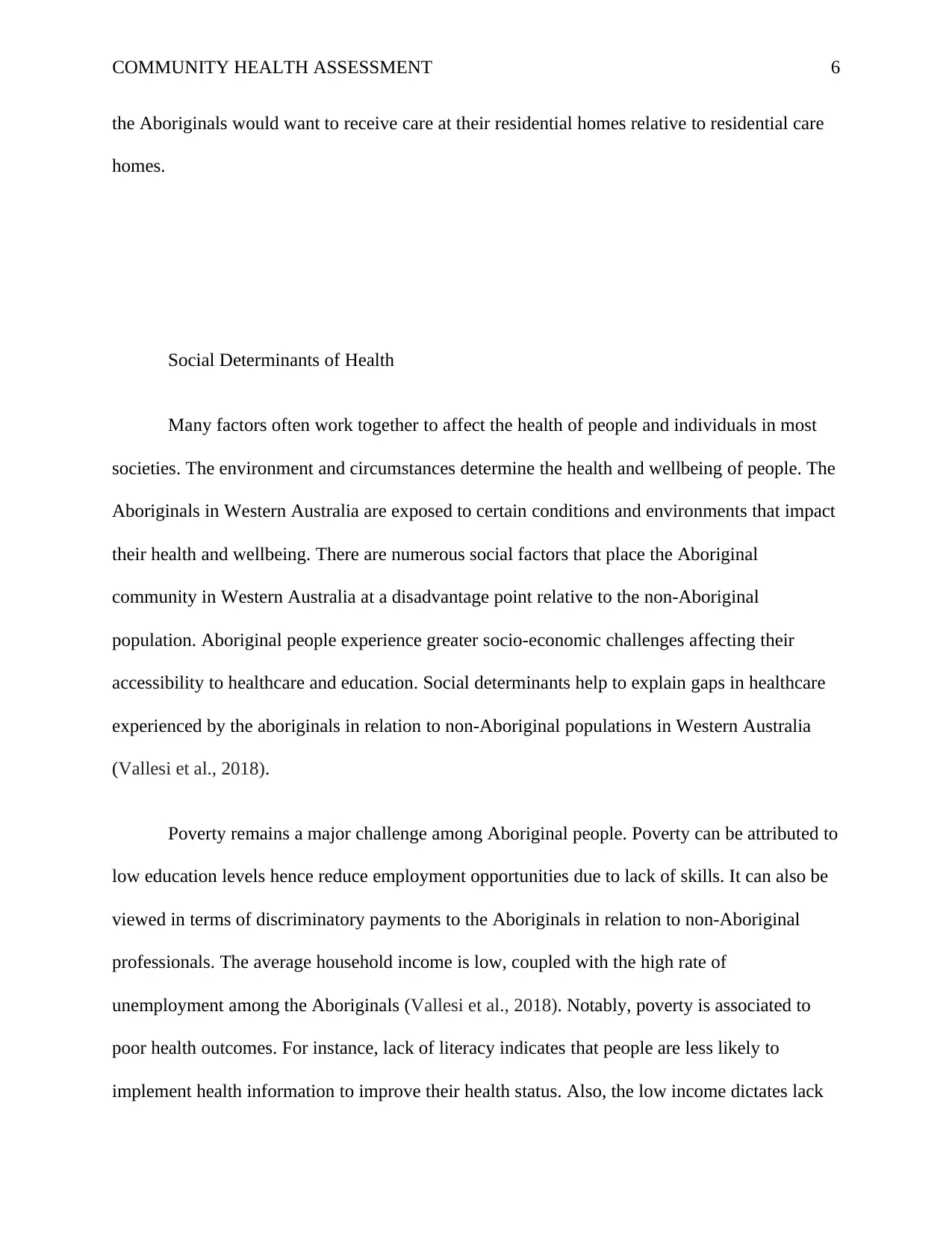
COMMUNITY HEALTH ASSESSMENT 6
the Aboriginals would want to receive care at their residential homes relative to residential care
homes.
Social Determinants of Health
Many factors often work together to affect the health of people and individuals in most
societies. The environment and circumstances determine the health and wellbeing of people. The
Aboriginals in Western Australia are exposed to certain conditions and environments that impact
their health and wellbeing. There are numerous social factors that place the Aboriginal
community in Western Australia at a disadvantage point relative to the non-Aboriginal
population. Aboriginal people experience greater socio-economic challenges affecting their
accessibility to healthcare and education. Social determinants help to explain gaps in healthcare
experienced by the aboriginals in relation to non-Aboriginal populations in Western Australia
(Vallesi et al., 2018).
Poverty remains a major challenge among Aboriginal people. Poverty can be attributed to
low education levels hence reduce employment opportunities due to lack of skills. It can also be
viewed in terms of discriminatory payments to the Aboriginals in relation to non-Aboriginal
professionals. The average household income is low, coupled with the high rate of
unemployment among the Aboriginals (Vallesi et al., 2018). Notably, poverty is associated to
poor health outcomes. For instance, lack of literacy indicates that people are less likely to
implement health information to improve their health status. Also, the low income dictates lack
the Aboriginals would want to receive care at their residential homes relative to residential care
homes.
Social Determinants of Health
Many factors often work together to affect the health of people and individuals in most
societies. The environment and circumstances determine the health and wellbeing of people. The
Aboriginals in Western Australia are exposed to certain conditions and environments that impact
their health and wellbeing. There are numerous social factors that place the Aboriginal
community in Western Australia at a disadvantage point relative to the non-Aboriginal
population. Aboriginal people experience greater socio-economic challenges affecting their
accessibility to healthcare and education. Social determinants help to explain gaps in healthcare
experienced by the aboriginals in relation to non-Aboriginal populations in Western Australia
(Vallesi et al., 2018).
Poverty remains a major challenge among Aboriginal people. Poverty can be attributed to
low education levels hence reduce employment opportunities due to lack of skills. It can also be
viewed in terms of discriminatory payments to the Aboriginals in relation to non-Aboriginal
professionals. The average household income is low, coupled with the high rate of
unemployment among the Aboriginals (Vallesi et al., 2018). Notably, poverty is associated to
poor health outcomes. For instance, lack of literacy indicates that people are less likely to
implement health information to improve their health status. Also, the low income dictates lack
⊘ This is a preview!⊘
Do you want full access?
Subscribe today to unlock all pages.

Trusted by 1+ million students worldwide
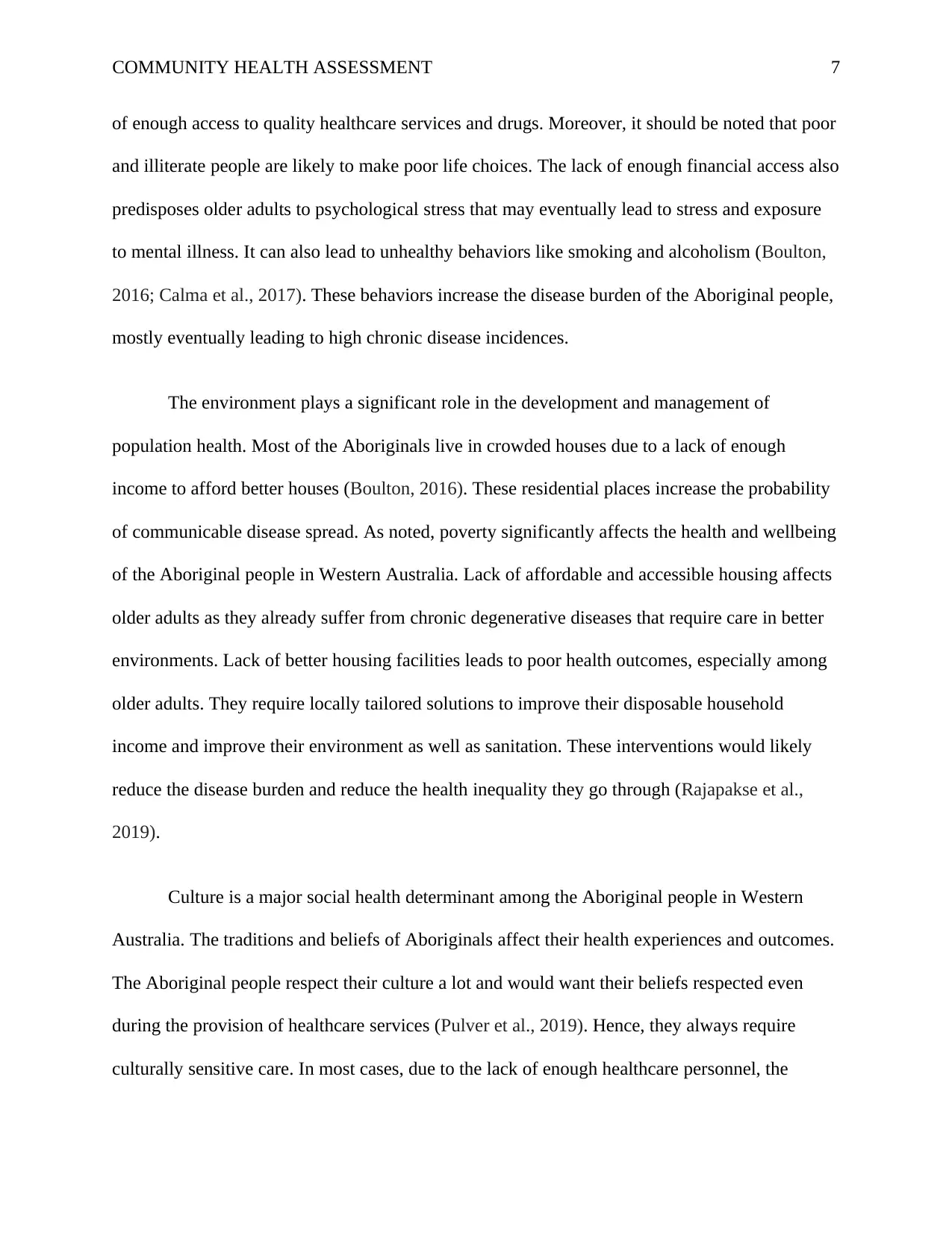
COMMUNITY HEALTH ASSESSMENT 7
of enough access to quality healthcare services and drugs. Moreover, it should be noted that poor
and illiterate people are likely to make poor life choices. The lack of enough financial access also
predisposes older adults to psychological stress that may eventually lead to stress and exposure
to mental illness. It can also lead to unhealthy behaviors like smoking and alcoholism (Boulton,
2016; Calma et al., 2017). These behaviors increase the disease burden of the Aboriginal people,
mostly eventually leading to high chronic disease incidences.
The environment plays a significant role in the development and management of
population health. Most of the Aboriginals live in crowded houses due to a lack of enough
income to afford better houses (Boulton, 2016). These residential places increase the probability
of communicable disease spread. As noted, poverty significantly affects the health and wellbeing
of the Aboriginal people in Western Australia. Lack of affordable and accessible housing affects
older adults as they already suffer from chronic degenerative diseases that require care in better
environments. Lack of better housing facilities leads to poor health outcomes, especially among
older adults. They require locally tailored solutions to improve their disposable household
income and improve their environment as well as sanitation. These interventions would likely
reduce the disease burden and reduce the health inequality they go through (Rajapakse et al.,
2019).
Culture is a major social health determinant among the Aboriginal people in Western
Australia. The traditions and beliefs of Aboriginals affect their health experiences and outcomes.
The Aboriginal people respect their culture a lot and would want their beliefs respected even
during the provision of healthcare services (Pulver et al., 2019). Hence, they always require
culturally sensitive care. In most cases, due to the lack of enough healthcare personnel, the
of enough access to quality healthcare services and drugs. Moreover, it should be noted that poor
and illiterate people are likely to make poor life choices. The lack of enough financial access also
predisposes older adults to psychological stress that may eventually lead to stress and exposure
to mental illness. It can also lead to unhealthy behaviors like smoking and alcoholism (Boulton,
2016; Calma et al., 2017). These behaviors increase the disease burden of the Aboriginal people,
mostly eventually leading to high chronic disease incidences.
The environment plays a significant role in the development and management of
population health. Most of the Aboriginals live in crowded houses due to a lack of enough
income to afford better houses (Boulton, 2016). These residential places increase the probability
of communicable disease spread. As noted, poverty significantly affects the health and wellbeing
of the Aboriginal people in Western Australia. Lack of affordable and accessible housing affects
older adults as they already suffer from chronic degenerative diseases that require care in better
environments. Lack of better housing facilities leads to poor health outcomes, especially among
older adults. They require locally tailored solutions to improve their disposable household
income and improve their environment as well as sanitation. These interventions would likely
reduce the disease burden and reduce the health inequality they go through (Rajapakse et al.,
2019).
Culture is a major social health determinant among the Aboriginal people in Western
Australia. The traditions and beliefs of Aboriginals affect their health experiences and outcomes.
The Aboriginal people respect their culture a lot and would want their beliefs respected even
during the provision of healthcare services (Pulver et al., 2019). Hence, they always require
culturally sensitive care. In most cases, due to the lack of enough healthcare personnel, the
Paraphrase This Document
Need a fresh take? Get an instant paraphrase of this document with our AI Paraphraser
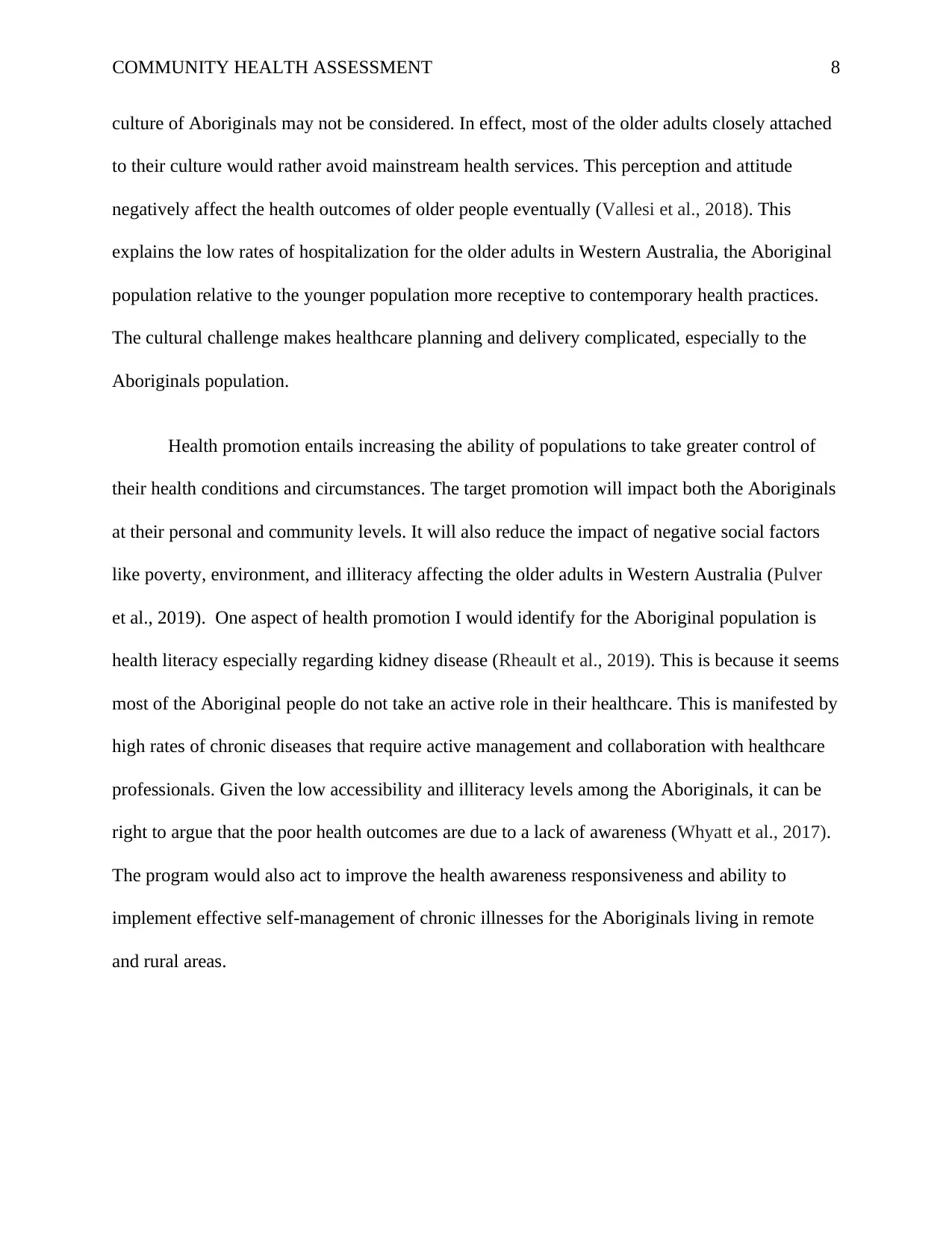
COMMUNITY HEALTH ASSESSMENT 8
culture of Aboriginals may not be considered. In effect, most of the older adults closely attached
to their culture would rather avoid mainstream health services. This perception and attitude
negatively affect the health outcomes of older people eventually (Vallesi et al., 2018). This
explains the low rates of hospitalization for the older adults in Western Australia, the Aboriginal
population relative to the younger population more receptive to contemporary health practices.
The cultural challenge makes healthcare planning and delivery complicated, especially to the
Aboriginals population.
Health promotion entails increasing the ability of populations to take greater control of
their health conditions and circumstances. The target promotion will impact both the Aboriginals
at their personal and community levels. It will also reduce the impact of negative social factors
like poverty, environment, and illiteracy affecting the older adults in Western Australia (Pulver
et al., 2019). One aspect of health promotion I would identify for the Aboriginal population is
health literacy especially regarding kidney disease (Rheault et al., 2019). This is because it seems
most of the Aboriginal people do not take an active role in their healthcare. This is manifested by
high rates of chronic diseases that require active management and collaboration with healthcare
professionals. Given the low accessibility and illiteracy levels among the Aboriginals, it can be
right to argue that the poor health outcomes are due to a lack of awareness (Whyatt et al., 2017).
The program would also act to improve the health awareness responsiveness and ability to
implement effective self-management of chronic illnesses for the Aboriginals living in remote
and rural areas.
culture of Aboriginals may not be considered. In effect, most of the older adults closely attached
to their culture would rather avoid mainstream health services. This perception and attitude
negatively affect the health outcomes of older people eventually (Vallesi et al., 2018). This
explains the low rates of hospitalization for the older adults in Western Australia, the Aboriginal
population relative to the younger population more receptive to contemporary health practices.
The cultural challenge makes healthcare planning and delivery complicated, especially to the
Aboriginals population.
Health promotion entails increasing the ability of populations to take greater control of
their health conditions and circumstances. The target promotion will impact both the Aboriginals
at their personal and community levels. It will also reduce the impact of negative social factors
like poverty, environment, and illiteracy affecting the older adults in Western Australia (Pulver
et al., 2019). One aspect of health promotion I would identify for the Aboriginal population is
health literacy especially regarding kidney disease (Rheault et al., 2019). This is because it seems
most of the Aboriginal people do not take an active role in their healthcare. This is manifested by
high rates of chronic diseases that require active management and collaboration with healthcare
professionals. Given the low accessibility and illiteracy levels among the Aboriginals, it can be
right to argue that the poor health outcomes are due to a lack of awareness (Whyatt et al., 2017).
The program would also act to improve the health awareness responsiveness and ability to
implement effective self-management of chronic illnesses for the Aboriginals living in remote
and rural areas.
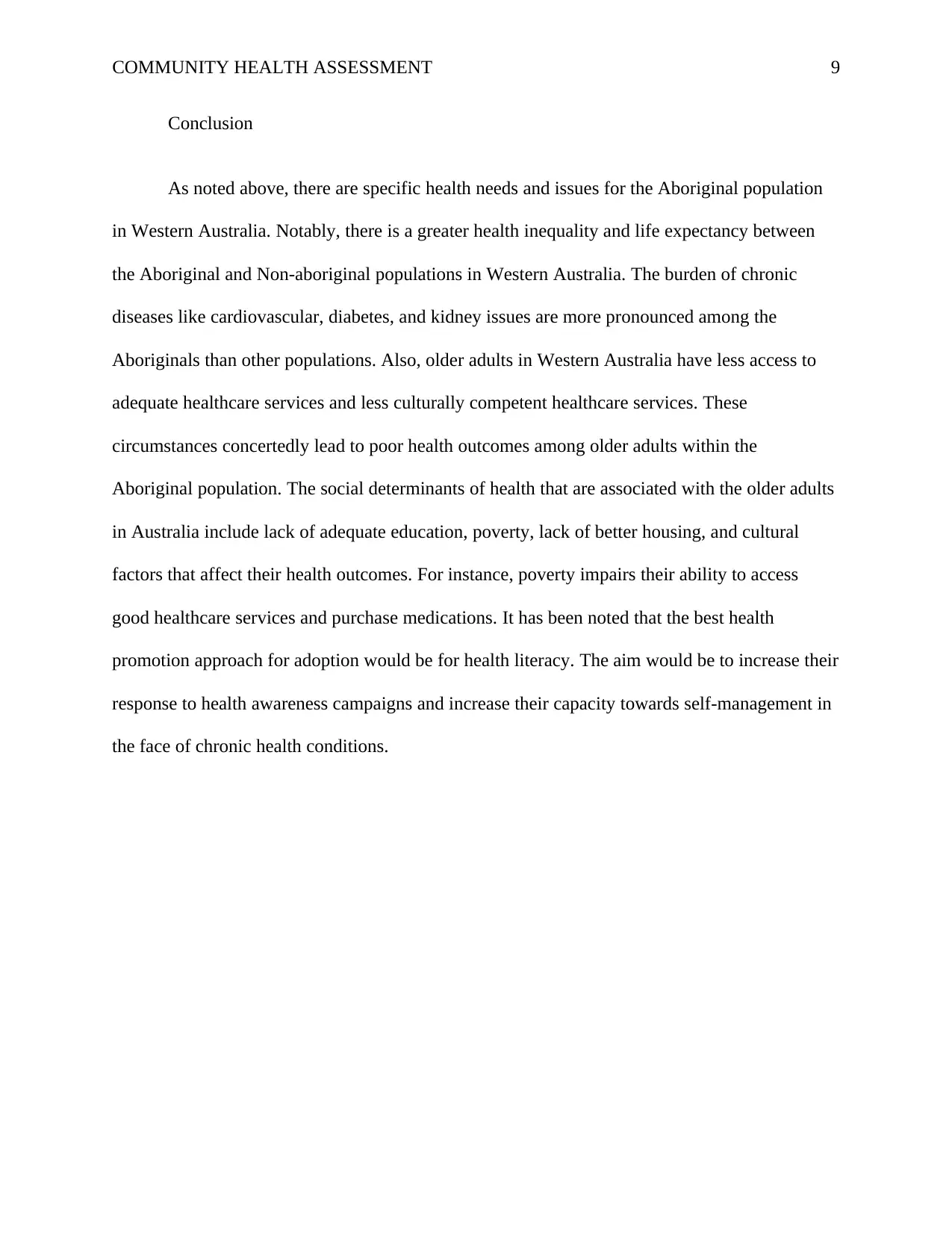
COMMUNITY HEALTH ASSESSMENT 9
Conclusion
As noted above, there are specific health needs and issues for the Aboriginal population
in Western Australia. Notably, there is a greater health inequality and life expectancy between
the Aboriginal and Non-aboriginal populations in Western Australia. The burden of chronic
diseases like cardiovascular, diabetes, and kidney issues are more pronounced among the
Aboriginals than other populations. Also, older adults in Western Australia have less access to
adequate healthcare services and less culturally competent healthcare services. These
circumstances concertedly lead to poor health outcomes among older adults within the
Aboriginal population. The social determinants of health that are associated with the older adults
in Australia include lack of adequate education, poverty, lack of better housing, and cultural
factors that affect their health outcomes. For instance, poverty impairs their ability to access
good healthcare services and purchase medications. It has been noted that the best health
promotion approach for adoption would be for health literacy. The aim would be to increase their
response to health awareness campaigns and increase their capacity towards self-management in
the face of chronic health conditions.
Conclusion
As noted above, there are specific health needs and issues for the Aboriginal population
in Western Australia. Notably, there is a greater health inequality and life expectancy between
the Aboriginal and Non-aboriginal populations in Western Australia. The burden of chronic
diseases like cardiovascular, diabetes, and kidney issues are more pronounced among the
Aboriginals than other populations. Also, older adults in Western Australia have less access to
adequate healthcare services and less culturally competent healthcare services. These
circumstances concertedly lead to poor health outcomes among older adults within the
Aboriginal population. The social determinants of health that are associated with the older adults
in Australia include lack of adequate education, poverty, lack of better housing, and cultural
factors that affect their health outcomes. For instance, poverty impairs their ability to access
good healthcare services and purchase medications. It has been noted that the best health
promotion approach for adoption would be for health literacy. The aim would be to increase their
response to health awareness campaigns and increase their capacity towards self-management in
the face of chronic health conditions.
⊘ This is a preview!⊘
Do you want full access?
Subscribe today to unlock all pages.

Trusted by 1+ million students worldwide
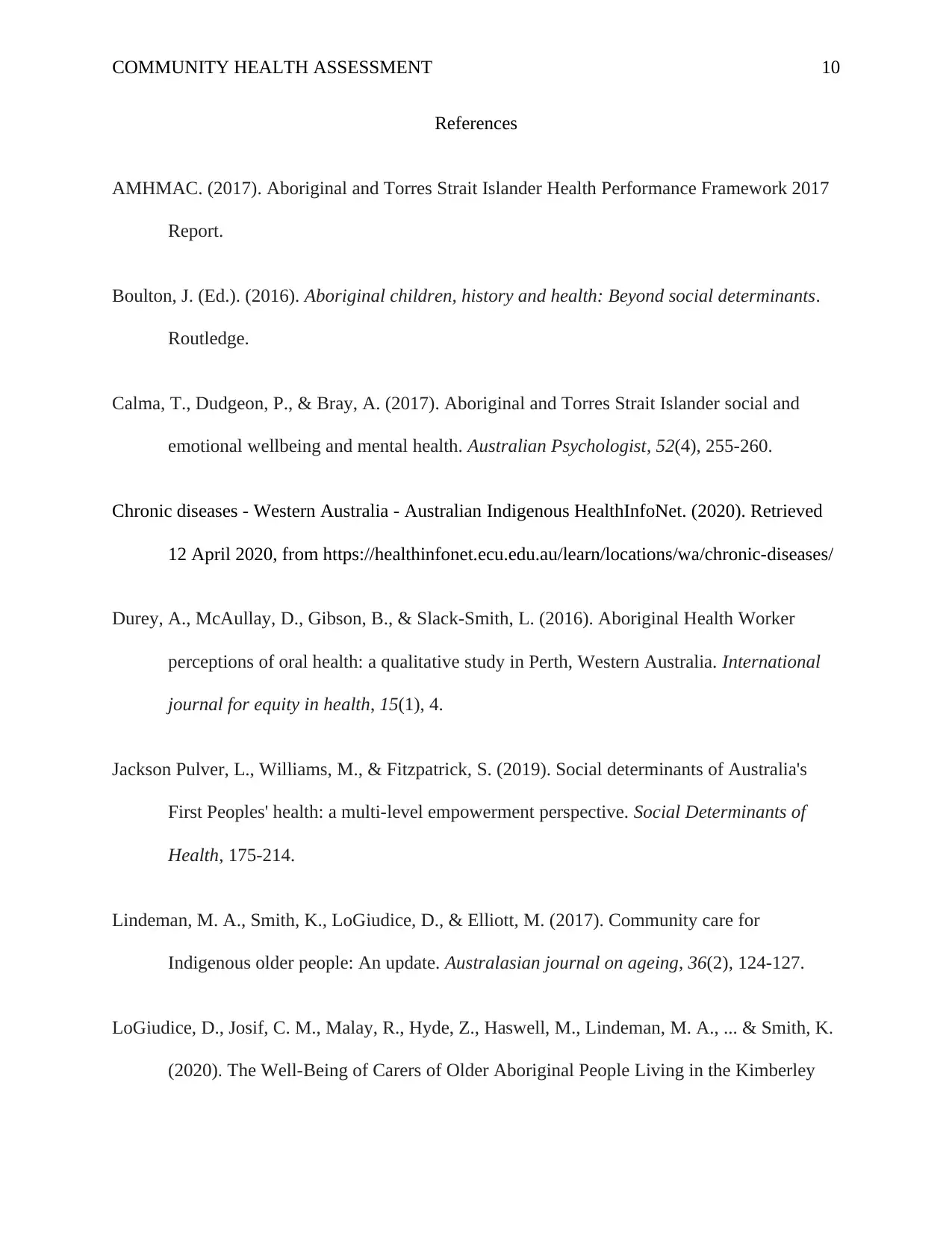
COMMUNITY HEALTH ASSESSMENT 10
References
AMHMAC. (2017). Aboriginal and Torres Strait Islander Health Performance Framework 2017
Report.
Boulton, J. (Ed.). (2016). Aboriginal children, history and health: Beyond social determinants.
Routledge.
Calma, T., Dudgeon, P., & Bray, A. (2017). Aboriginal and Torres Strait Islander social and
emotional wellbeing and mental health. Australian Psychologist, 52(4), 255-260.
Chronic diseases - Western Australia - Australian Indigenous HealthInfoNet. (2020). Retrieved
12 April 2020, from https://healthinfonet.ecu.edu.au/learn/locations/wa/chronic-diseases/
Durey, A., McAullay, D., Gibson, B., & Slack-Smith, L. (2016). Aboriginal Health Worker
perceptions of oral health: a qualitative study in Perth, Western Australia. International
journal for equity in health, 15(1), 4.
Jackson Pulver, L., Williams, M., & Fitzpatrick, S. (2019). Social determinants of Australia's
First Peoples' health: a multi-level empowerment perspective. Social Determinants of
Health, 175-214.
Lindeman, M. A., Smith, K., LoGiudice, D., & Elliott, M. (2017). Community care for
Indigenous older people: An update. Australasian journal on ageing, 36(2), 124-127.
LoGiudice, D., Josif, C. M., Malay, R., Hyde, Z., Haswell, M., Lindeman, M. A., ... & Smith, K.
(2020). The Well-Being of Carers of Older Aboriginal People Living in the Kimberley
References
AMHMAC. (2017). Aboriginal and Torres Strait Islander Health Performance Framework 2017
Report.
Boulton, J. (Ed.). (2016). Aboriginal children, history and health: Beyond social determinants.
Routledge.
Calma, T., Dudgeon, P., & Bray, A. (2017). Aboriginal and Torres Strait Islander social and
emotional wellbeing and mental health. Australian Psychologist, 52(4), 255-260.
Chronic diseases - Western Australia - Australian Indigenous HealthInfoNet. (2020). Retrieved
12 April 2020, from https://healthinfonet.ecu.edu.au/learn/locations/wa/chronic-diseases/
Durey, A., McAullay, D., Gibson, B., & Slack-Smith, L. (2016). Aboriginal Health Worker
perceptions of oral health: a qualitative study in Perth, Western Australia. International
journal for equity in health, 15(1), 4.
Jackson Pulver, L., Williams, M., & Fitzpatrick, S. (2019). Social determinants of Australia's
First Peoples' health: a multi-level empowerment perspective. Social Determinants of
Health, 175-214.
Lindeman, M. A., Smith, K., LoGiudice, D., & Elliott, M. (2017). Community care for
Indigenous older people: An update. Australasian journal on ageing, 36(2), 124-127.
LoGiudice, D., Josif, C. M., Malay, R., Hyde, Z., Haswell, M., Lindeman, M. A., ... & Smith, K.
(2020). The Well-Being of Carers of Older Aboriginal People Living in the Kimberley
Paraphrase This Document
Need a fresh take? Get an instant paraphrase of this document with our AI Paraphraser
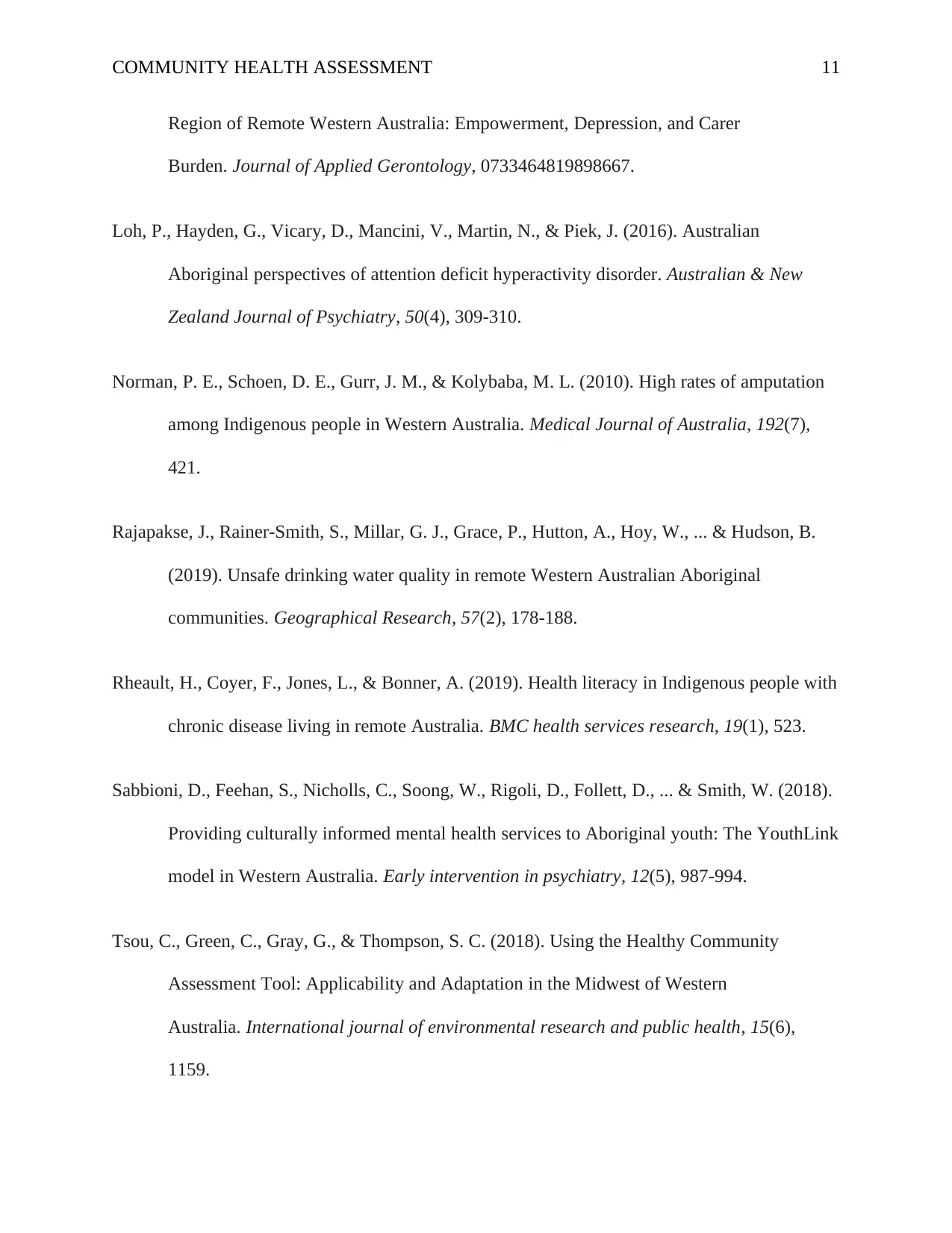
COMMUNITY HEALTH ASSESSMENT 11
Region of Remote Western Australia: Empowerment, Depression, and Carer
Burden. Journal of Applied Gerontology, 0733464819898667.
Loh, P., Hayden, G., Vicary, D., Mancini, V., Martin, N., & Piek, J. (2016). Australian
Aboriginal perspectives of attention deficit hyperactivity disorder. Australian & New
Zealand Journal of Psychiatry, 50(4), 309-310.
Norman, P. E., Schoen, D. E., Gurr, J. M., & Kolybaba, M. L. (2010). High rates of amputation
among Indigenous people in Western Australia. Medical Journal of Australia, 192(7),
421.
Rajapakse, J., Rainer‐Smith, S., Millar, G. J., Grace, P., Hutton, A., Hoy, W., ... & Hudson, B.
(2019). Unsafe drinking water quality in remote Western Australian Aboriginal
communities. Geographical Research, 57(2), 178-188.
Rheault, H., Coyer, F., Jones, L., & Bonner, A. (2019). Health literacy in Indigenous people with
chronic disease living in remote Australia. BMC health services research, 19(1), 523.
Sabbioni, D., Feehan, S., Nicholls, C., Soong, W., Rigoli, D., Follett, D., ... & Smith, W. (2018).
Providing culturally informed mental health services to Aboriginal youth: The YouthLink
model in Western Australia. Early intervention in psychiatry, 12(5), 987-994.
Tsou, C., Green, C., Gray, G., & Thompson, S. C. (2018). Using the Healthy Community
Assessment Tool: Applicability and Adaptation in the Midwest of Western
Australia. International journal of environmental research and public health, 15(6),
1159.
Region of Remote Western Australia: Empowerment, Depression, and Carer
Burden. Journal of Applied Gerontology, 0733464819898667.
Loh, P., Hayden, G., Vicary, D., Mancini, V., Martin, N., & Piek, J. (2016). Australian
Aboriginal perspectives of attention deficit hyperactivity disorder. Australian & New
Zealand Journal of Psychiatry, 50(4), 309-310.
Norman, P. E., Schoen, D. E., Gurr, J. M., & Kolybaba, M. L. (2010). High rates of amputation
among Indigenous people in Western Australia. Medical Journal of Australia, 192(7),
421.
Rajapakse, J., Rainer‐Smith, S., Millar, G. J., Grace, P., Hutton, A., Hoy, W., ... & Hudson, B.
(2019). Unsafe drinking water quality in remote Western Australian Aboriginal
communities. Geographical Research, 57(2), 178-188.
Rheault, H., Coyer, F., Jones, L., & Bonner, A. (2019). Health literacy in Indigenous people with
chronic disease living in remote Australia. BMC health services research, 19(1), 523.
Sabbioni, D., Feehan, S., Nicholls, C., Soong, W., Rigoli, D., Follett, D., ... & Smith, W. (2018).
Providing culturally informed mental health services to Aboriginal youth: The YouthLink
model in Western Australia. Early intervention in psychiatry, 12(5), 987-994.
Tsou, C., Green, C., Gray, G., & Thompson, S. C. (2018). Using the Healthy Community
Assessment Tool: Applicability and Adaptation in the Midwest of Western
Australia. International journal of environmental research and public health, 15(6),
1159.
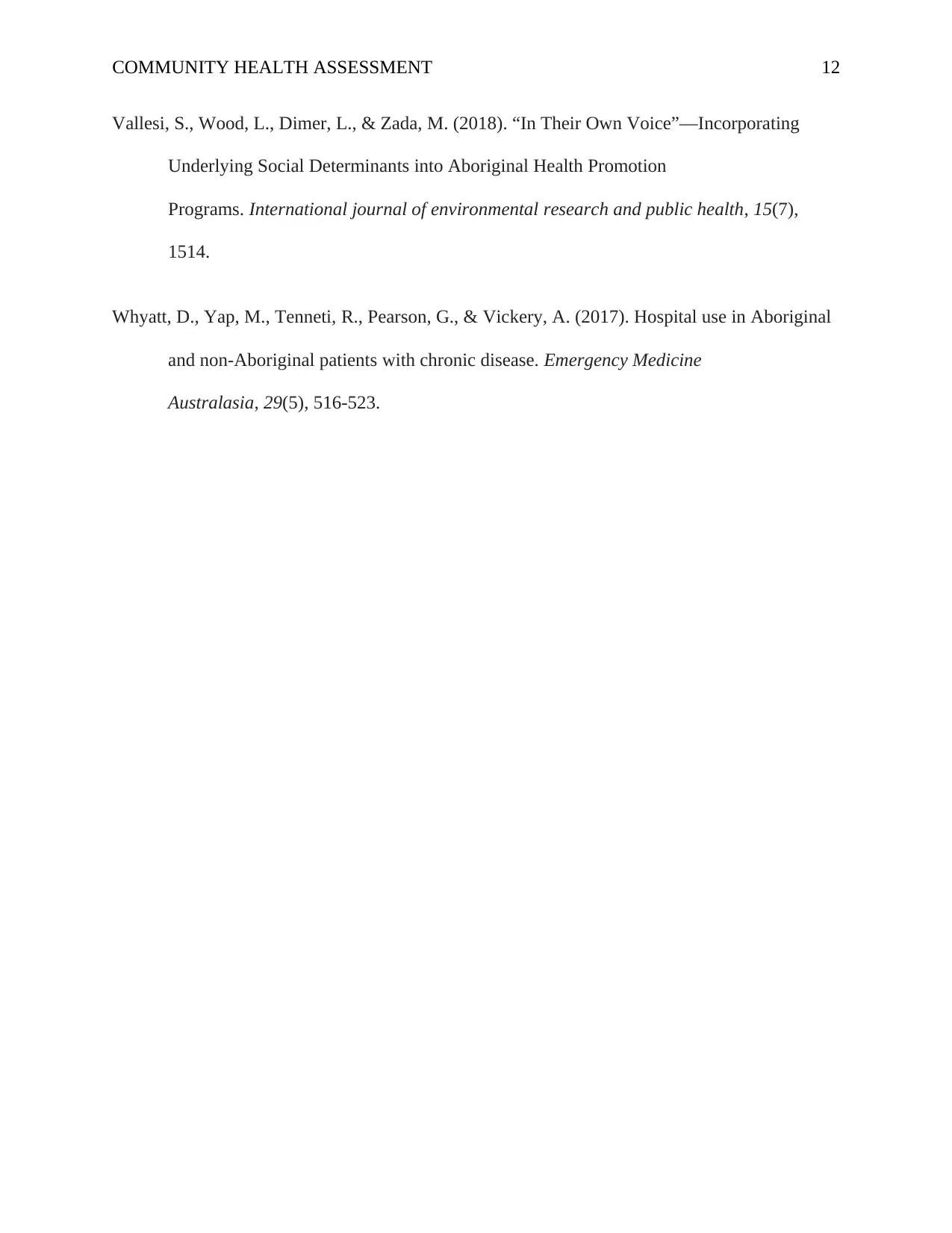
COMMUNITY HEALTH ASSESSMENT 12
Vallesi, S., Wood, L., Dimer, L., & Zada, M. (2018). “In Their Own Voice”—Incorporating
Underlying Social Determinants into Aboriginal Health Promotion
Programs. International journal of environmental research and public health, 15(7),
1514.
Whyatt, D., Yap, M., Tenneti, R., Pearson, G., & Vickery, A. (2017). Hospital use in Aboriginal
and non‐Aboriginal patients with chronic disease. Emergency Medicine
Australasia, 29(5), 516-523.
Vallesi, S., Wood, L., Dimer, L., & Zada, M. (2018). “In Their Own Voice”—Incorporating
Underlying Social Determinants into Aboriginal Health Promotion
Programs. International journal of environmental research and public health, 15(7),
1514.
Whyatt, D., Yap, M., Tenneti, R., Pearson, G., & Vickery, A. (2017). Hospital use in Aboriginal
and non‐Aboriginal patients with chronic disease. Emergency Medicine
Australasia, 29(5), 516-523.
⊘ This is a preview!⊘
Do you want full access?
Subscribe today to unlock all pages.

Trusted by 1+ million students worldwide
1 out of 12
Related Documents
Your All-in-One AI-Powered Toolkit for Academic Success.
+13062052269
info@desklib.com
Available 24*7 on WhatsApp / Email
![[object Object]](/_next/static/media/star-bottom.7253800d.svg)
Unlock your academic potential
Copyright © 2020–2025 A2Z Services. All Rights Reserved. Developed and managed by ZUCOL.





